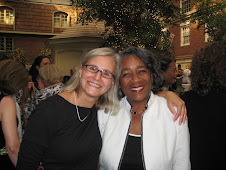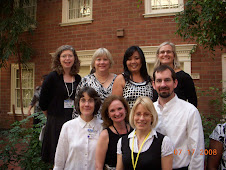Kelly Wheaton, literacy coach at Valley View, found a great website the contains links to a number of literacy strategies. Many of the strategies collected there are the same strategies that people have learned from NUA.
Click on the Adolescent Literacy website to check out their descriptions of a number of strategies.
Showing posts with label anticipation guide. Show all posts
Showing posts with label anticipation guide. Show all posts
Tuesday, February 3, 2009
Wednesday, December 5, 2007
Reading in Chemistry Foundations
The chemistry foundations class for sophomores includes reading about relevant, real-world connections to chemistry. In fact, their textbook, Chemistry in the Community, includes many stories about the real-world applications of chemistry.
In preparation for the sophomore state reading test, Chemistry Teachers Chad Nyberg, Dana Weiland and Mike Roddy used some NUA strategies in a lesson as part of the introduction to the heavy metals unit.
The lesson began with an anticipation guide listing statements that would be discovered in the readings that day. The lesson involved four articles for a group jigsaw, so a few statements were made from each reading. Upon reflection, however, the cumulative amount of statements was too large for the time allowed. Around five statements total would have proven sufficient to start the discussion of the impact of heavy metals on people's health.
After the students shared a few responses to anticipation guide statements, they formed groups of four, and each student read a different article. Two articles were on lead poisoning, and two were on mercury poisoning. As students read their assigned article, they completed a 4-Square writing that required the students to find three main ideas and supporting details for each main idea. The fourth square was where students recorded the author's purpose for writing the article. Although the fourth square is typically for a conclusion statement, we changed the box to purpose since we felt purpose was close to a student's final thoughts on an article and since the GRAD reading test often asks the question: What is the author's purpose.
After reading and writing about their articles, students shared the information with their groups, and then the groups re-visited their anticipation guides, discussing and correcting any of the statements.
The format for 4-Square Writing looks like this:

In preparation for the sophomore state reading test, Chemistry Teachers Chad Nyberg, Dana Weiland and Mike Roddy used some NUA strategies in a lesson as part of the introduction to the heavy metals unit.
The lesson began with an anticipation guide listing statements that would be discovered in the readings that day. The lesson involved four articles for a group jigsaw, so a few statements were made from each reading. Upon reflection, however, the cumulative amount of statements was too large for the time allowed. Around five statements total would have proven sufficient to start the discussion of the impact of heavy metals on people's health.
After the students shared a few responses to anticipation guide statements, they formed groups of four, and each student read a different article. Two articles were on lead poisoning, and two were on mercury poisoning. As students read their assigned article, they completed a 4-Square writing that required the students to find three main ideas and supporting details for each main idea. The fourth square was where students recorded the author's purpose for writing the article. Although the fourth square is typically for a conclusion statement, we changed the box to purpose since we felt purpose was close to a student's final thoughts on an article and since the GRAD reading test often asks the question: What is the author's purpose.
After reading and writing about their articles, students shared the information with their groups, and then the groups re-visited their anticipation guides, discussing and correcting any of the statements.
The format for 4-Square Writing looks like this:

Labels:
4-square writing,
anticipation guide,
reading,
writing
Wednesday, September 19, 2007
Anticipation Guide to Engage Students
An anticipation guide is a set of true/false or agree/disagree statements that are presented to students prior to informational text (including math chapters), films, and guest speakers. The strategy sharpens a student's thinking skills while building curiosity. When information is memorable, student learning increases.
The steps:
Generally, anticipation guides are used with non-fiction texts so that students can reason with prior knowledge. With fiction, the author could take the reader anywhere. However, anticipation guides can be successful with fiction when the agree/disagree statements get at the big ideas or themes of the novel.
Here are some example fiction statements for anticipation guides:
Huxley's Brave New World--
A society's stability is hindered by people expressing their individuality.
Twain's Adventures of Huckleberry Finn--
A natural father's rights are more important than a child's welfare.
Shakespeare's Much Ado About Nothing--
Before deciding to marry someone, people need to agree with their parents' wishes.
This strategy is culturally responsive because students share their reasoning behind statements with small groups and the entire class. Since the reasoning is based on what students know, various cultural backgrounds will emerge. Hopefully, this leads to students appreciating other backgrounds and life experiences.
English 10 teachers used an Anticipation Guide during the first week of school where students agreed or disagreed with statements about life if high school. This activity worked well.
KC even created an anticipation guide of personal information as a way for students to get to know their teacher.
The steps:
- The teacher writes several declarative statements that are based on the upcoming reading, film, chapter, speaker, etc. The best statements are possible yet open for debate.
- Before the reading, students decide on their response. Students could complete the anticipation guide with just their own opinions and then check with a partner or group.
- The group discusses some of the statements as a whole class, having students tell the reasoning behind the response. The teacher can prompt: "Why do you think so?
- Students read the assigned material and change their answers so that they leave class with the correct answers to study.
Generally, anticipation guides are used with non-fiction texts so that students can reason with prior knowledge. With fiction, the author could take the reader anywhere. However, anticipation guides can be successful with fiction when the agree/disagree statements get at the big ideas or themes of the novel.
Here are some example fiction statements for anticipation guides:
Huxley's Brave New World--
A society's stability is hindered by people expressing their individuality.
Twain's Adventures of Huckleberry Finn--
A natural father's rights are more important than a child's welfare.
Shakespeare's Much Ado About Nothing--
Before deciding to marry someone, people need to agree with their parents' wishes.
This strategy is culturally responsive because students share their reasoning behind statements with small groups and the entire class. Since the reasoning is based on what students know, various cultural backgrounds will emerge. Hopefully, this leads to students appreciating other backgrounds and life experiences.
English 10 teachers used an Anticipation Guide during the first week of school where students agreed or disagreed with statements about life if high school. This activity worked well.
KC even created an anticipation guide of personal information as a way for students to get to know their teacher.
Labels:
anticipation guide,
cognition,
culture,
math,
reading
Sunday, September 2, 2007
NUA Insights and Applications from the CoP
On the last day of the high school NUA CoP, people shared the following summary statements from their key word notes page to provide a quick review of the weeks activities:
In addition, CoP members shared the following specific strategies that they plan on implementing in the classroom in the coming weeks:
- NUA strategies address culture, language and cognition and require students to think about their thinking.
- NUA and Thinking Maps address classroom management by bridging the culture and achievement gaps.
- NUA provides a variety of strategies to assist students in learning with particular attention to culture, language and cognition.
- NUA strategies provide a common language to foster equity in learning that sometimes doesn't occur.
- Thinking Maps connect all disciplines to all cultures.
- I have a better grasp of NUA foundations. The research with Gifted and Talented students has mixed results since 10% of students said their writing skills declined because of Thinking Maps, but students were self reporting.
In addition, CoP members shared the following specific strategies that they plan on implementing in the classroom in the coming weeks:
- Ann will use the multi-flow map with students to discuss the causes and effects of controlling their asthma and the double bubble map to compare and contrast rescue inhalers with preventative inhalers.
- Elizabeth will implement the notebook this year to cut down on photocopying and help students get organized.
- KC, and the other English 10 teachers, are using an anticipation guide for community building in the first few days of school. KC has teacher facts on one anticipation guide. Another one English 10 will use is "High School Anticipation Guide" with questions about academic honesty and high school concerns. Many of the questions will be answered in the syllabus.
- Jim is doing his anticipation guides on surveymonkey.com and linking to his blog.
- Betsy pointed out that blogger just added the poll option so that teachers could do a weekly poll on an issue.
- Jackie has a flow map of the semester units on her bulletin board to build interest. Heidi (not a CoP member but an NUA Cohort member who shared this idea) is building a flow map across her wall as a unit progresses. Scott will consider doing this in his math class on his back white board. He could have each day's outcome summarized with a Thinking Map which flows into the next day's map summary or items learned list.
- Jackie is also adapting many of Baruti Kafele's classroom management ideas. She has a vision statement on the bulletin board, a wall of fame in back, teleflip text messaging for positive comments, student goal setting on a multi-flow map, highlighting students through their Ipods, and putting an essential question of the day and agenda on the white board each day so that students know what they are supposed to get from each day.
Wednesday, August 29, 2007
Anticipation Guide
 The tree map above was created during the CoP's debrief after the didgeridoo anticipation guide and subsequent reading. Many people are planning to use an anticipation guide early in the year to spark student curiosity for reading from novels to math textbooks.
The tree map above was created during the CoP's debrief after the didgeridoo anticipation guide and subsequent reading. Many people are planning to use an anticipation guide early in the year to spark student curiosity for reading from novels to math textbooks.To watch the apnea-free Jeremy flex his neck muscles, click here.
Labels:
anticipation guide,
cognition,
language strategies,
reading
Subscribe to:
Posts (Atom)






